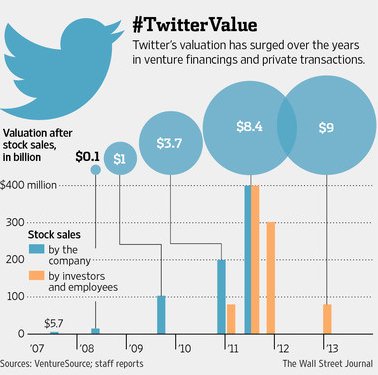So what’s involved with a fair company valuation? Just because one company is valued in one way, doesn’t mean another company must follow the same valuation rules.
Though what is evident is that we are comparing apples to apples when it comes to company valuations.
Professor Dupont looks at a fair valuation for Twitter.
The real value of Twitter or any business for that matter, is equivalent to what buyers are prepared to pay. Before deciding how to value a business, Professor Dupont explains that you should establish the prices paid for similar businesses in recent years.
Now here comes the problem for correctly valuating Twitter. Where is a similar business to Twitter? It’s a one-of-a-kind business, and so too is Instagram, Facebook, and other similar properties where they have no competitors running the same business model.
While this benchmarking cannot be treated as a formal valuation, it does provide an initial guide to the likely market price.
We have to start somewhere however, and so there are a number of methods used to value businesses like Twitter. No one method is more valid than another, and valuations are usually based on a combination of methods.
The 2 most common valuation methods are:
- calculating a business’s net worth (i.e. assets minus liabilities)
- valuing based on the business’s income or profits and the expected return on investment (ROI).
In a raw sense, the net worth Twitter is essentially the difference between what it owns (assets) and what it owes (liabilities). Assets minus liabilities equals net worth.
When calculating Twitter’s business net worth, Professor Dupont explains that you need to consider both tangible assets (such as buildings and hardware) and intangible assets (such as future earning potential and intellectual property).
The drawbacks of this method are that valuing Twitter’s intangible assets can be difficult. Additionally, it doesn’t take into account the premium that might be justified for strong growth or discounts for lacklustre share price movement.
Valuation based on annual net profit
Now here comes a huge problem with valuing Twitter and other high tech companies that may not have yet made any profit.
Some people prefer to value businesses based on a business’s annual net profit. Many industries have a ratio for valuing a business in this way. For example, the marketplace may value a particular type of business — as long as it’s secure — at 3 times its annual net profit. However, a less secure business in the same industry might sell for only twice the annual net profit.

So it boils down to this.
At this point in the valuation of Twitter, you’ll usually need to select a valuation method or combination of methods. It’s usually a combination of methods that the marketplace uses.

